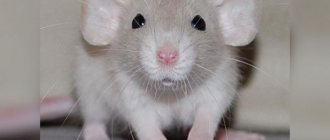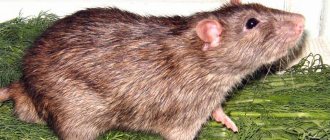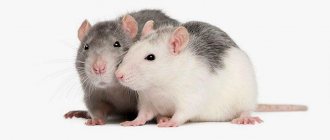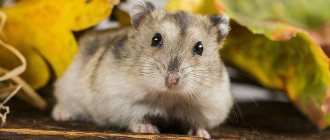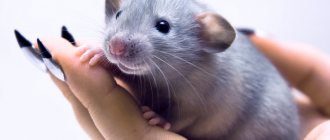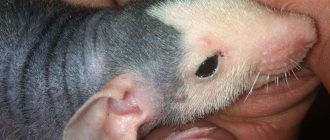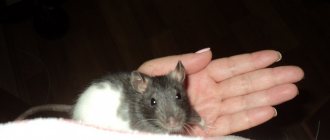The rat is considered one of the most intelligent and cunning species of rodents. And if you are now wincing with disgust and hostility towards this animal, then, most likely, you thought about the inhabitants of garbage dumps and basements, who are capable of carrying a myriad of diseases and infections. Another thing is decorative rodents, which can become an excellent friend for a pet lover in small apartments.
About who rats are, how they behave, what diseases domestic rats have, how to properly care for them, whether it is possible to wash decorative rats and much more - in our article.
Rat as a pet
Whatever animal you choose as a pet, you should remember the responsibility to the animal: it will have to be looked after, fed and loved, regardless of size, activity and type.
Often, future owners of four-legged animals mistakenly believe that if the animal is large, then there is a lot of trouble with it, and if it is small, then it does not require time. But in reality it's not like that. And often a tiny decorative rat requires more care than a huge guard dog. Therefore, if you are not ready to take on a number of responsibilities for caring for an animal, think about whether you want this responsibility or should you wait.
Development of baby rats by day
Rats grow very quickly. After 4 weeks they already become adults, and at 5-6 weeks they reach puberty.
Development of small rodents by day:
- Day 1 - defenseless, blind and deaf babies with underdeveloped limbs and a small tail. They can suckle milk, sleep and squeak a lot.
- Day 3 - ears open.
- 5-6 days - hair appears. The skin color changes from pink to flesh-colored, there are dark spots.
- 8-10 days - the first teeth erupt. The cubs become very active.
- 12-13 days - eyes open.
- 14-16 days - secondary sexual characteristics are formed. The owner can determine the sex of the pups. Females have noticeable nipples on their abdomen.
- 16-17 days - they begin to eat with their mother. They chew everything that surrounds them.
- 20-27 days - rat pups are already formed independent individuals who eat adult food.
- 28-30 days - they are already fully grown. They become very curious, recognize people and love to play with them.
Breeds of domestic rats
Today there are 137 species of domestic rats, as well as 570 subspecies . And each of them is interesting in its own way. The most common:
- breed of decorative rat - standard,
- tailless rats,
- rexes and double rexes,
- satin types,
- hairless,
- decorative dumbo rats,
- downy
At the same time, the color of decorative rats can be uniform, ticked (with a pattern) or combined. White domestic rats, gray domestic rats, and black decorative rats are often found. Less often - with hearts, spots and stripes.
Female care for cubs
An animal of this species is an excellent mother. The female spends around the clock with the cubs, caring for, fattening and taking care of each baby. She uses her own body to cover the children, warming and protecting them.
The warmth that comes from the rat's body and frequent feeding of milk activate the formation of the body systems of newborn rat pups. It is practically impossible to fatten and protect a newborn baby without maternal care.
Keeping a rat at home
If you have no doubts about your decision to have a rat as a pet, be sure to find out all the features of keeping this type of rodent in your home.
For example, a rat has a very direct relationship with rodents - therefore, walking around the apartment, it will find something to chew on: from shoe laces to equipment wires. In this regard, the animal is either not allowed to go on such walks unattended, or all dangerous or valuable objects are removed in advance.
The second feature of the rat is its smell, which indicates the mark of the territory of residence. Ask yourself, are you ready for fragrant surprises?
Thirdly, rats are afraid of drafts and direct sunlight - you need to remember this when placing your pet’s cage (i.e., a window sill is definitely not a suitable place).
Please note that the comfortable air temperature for a rat is 18-21 °C (despite the fact that the body temperature of a decorative rat is higher than a human one - 38.3-39.3 degrees).
Cell selection
The best home for such a rodent is a large and spacious cage (not a jar, not a container or a box). You can buy it at any pet store - complete with ladders, house, feeder and drinking bowl or separately from them. Some owners make accessories for their pets with their own hands (let us just remember that plywood and cardboard are chewed off quite quickly, and the item will have to be replaced). Of course, the animal will really like and will not get bored with such elements as hanging shelves, a running wheel, swings, and branches that can be climbed. This will be especially appreciated by young individuals, but the “oldies” do not need so much entertainment when decorating the interior of the cage.
When choosing filler for the cage, give preference to large sawdust (small particles of wood species can get into the animal’s eyes, nose or ears and cause an allergic reaction). If you use paper as a bedding, it should be clean, without paint, writing or typography.
Cotton wool is not suitable as a filler!
The cage must be cleaned at least once a week. Be sure to do a complete disinfection to eliminate the risk of infecting your rat with parasites, bacteria and microbes that may appear in a dirty cage.
How long should baby rats stay with their mothers?
Usually six weeks. This includes a period of nursing the cubs and their final weaning after approximately 5 weeks (21 days).
Many people ask this question, especially when they find orphan rats. What to do if you find orphan rats? How to feed them? As mentioned earlier, if the mother is unable to nurse, you can feed the rat baby formula. Just be sure to seek help from a veterinarian.
What to feed your pet rat?
It is not enough to know about the care and maintenance of a pet rat: feeding is an equally important aspect, because the pet constantly needs clean and fresh water and food. For liquids, a drinking bowl is placed so that the water does not spill and the cage does not become dirty and damp. The water needs to be changed every day.
The food should include grains (oats, wheat, millet, barley), fruits (apples, bananas, peaches, apricots, persimmons), berries (grapes, strawberries, raspberries), vegetables, herbs (dandelion and plantain leaves), dried fruits , nuts (except almonds) and chicken bones (necessary for grinding teeth). You can give meat, but in small portions and no more than once a week.
The normal feeding frequency is 2 times a day for adults, 3-4 times for children and adolescents.
Additionally, owners purchase a mineral stone that can provide the animal with the necessary amount of calcium.
List of prohibited products:
- roast,
- salty,
- smoked,
- fatty,
- spicy,
- cold,
- sweet.
So candy, chocolate, sausage, bread, soy are not an option. Vegetables such as cabbage, turnips, radishes, radishes, beets, legumes and raw potatoes should not be given. All permitted vegetables and fruits must be ripe (not green, but not overripe). Do not offer your rat leaves from indoor plants or fruit trees.
A properly selected diet is the key to animal health. It’s easy to put together if you know what pet rats eat and what you should absolutely not give.
A little history
Cute, affectionate and tame decorative rats are descended from ordinary wild gray rats, which cause a feeling of disgust in humans, as well as a certain fear. This is not at all surprising, since wild rats have gained notoriety not only for their behavior, but also for their ability to spread various viruses and infections.
The Chinese and Indians first became aware of wild rats several thousand years ago. In the 16th century, as maritime trade developed, rats spread throughout the world, moving from continent to continent. In the 19th century in England, these rodents began to be used in battles against dogs, after catching them. During the same period, some hobbyists began breeding rats, especially tame, white ones. Such tame rodents were shown at exhibitions; in addition, white rats took part in circus performances. Some pet lovers started keeping rodents in their homes because they did not pose any danger to humans.
Some of the individuals were used as experimental animals in various laboratories, which is still practiced today, and some of them moved into the homes of scientists. Scientists saw in rats animals that are quite intelligent and attached to humans. Thanks to the crossing of laboratory rats with wild animals, new species and breeds of domestic decorative rodents have appeared, which can still be found among various breeders.
Diseases of decorative rats
Rats, like many other decorative rodents, can be overtaken by a variety of diseases, some of which are dangerous for humans. The causes of illnesses can be parasites, bacteria, viruses, fungi.
The following diseases are common:
- ectromelia (also known as smallpox) is a virus that, when it falls into the animal’s body, multiplies on the skin and internal organs (in the chronic form, ulcers, swelling and spots appear on the skin, which ends in tissue necrosis and gangrene; in the acute stage, there may be no symptoms, but the rat will die within 24 hours);
- listeriosis is a bacterial infection that is also dangerous for humans (infection occurs through bedding, food and cage accessories); body temperature rises, coordination is impaired;
- salmonellosis is a bacterium manifested by apathy, diarrhea, intermittent breathing, and without treatment it turns into edema, paralysis and irreversible organ damage (treated with antibiotics - chloramphenicol, biseptol, sulfadimethoxine);
- pneumonia - damage to the respiratory system by pathogens coronavirus and Sendai virus, manifested by discharge from the nose and eyes, sneezing, difficulty breathing, redness of the eyes, swelling of the throat, apathy, weight loss (treated with a course of antibiotics, anti-inflammatory drugs, immunomodulators and vitamins);
- mycoplasmosis - a genital, respiratory or mixed infection, manifested by enlarged lymph nodes, nasal discharge, pneumonia (the genital form may be asymptomatic);
- coccidiosis - a disease of the intestines and liver with frequent digestive disorders, jaundice, exhaustion;
- scab and actinomycosis are a fungus that enters the rat’s body after flea or tick bites, as well as through contaminated food (symptoms are ulcers, grayish blisters, scabs on the skin, hair loss, abscesses on the mucous membranes in the mouth).
Many diseases can be avoided if you wash your hands after handling your pet, give proven food and keep the animal’s cage clean.
Now you know how to care for a rat at home. Following all the recommendations is not very troublesome, but your smart animal will definitely thank you with its attention and love.
Cell selection
All a rat needs is a spacious cage with accessories, tasty nutritious food and a loving owner. A cage for a furry pet becomes a home in which it spends most of its life, so you need to pay special attention to buying a home for your little friend. A cage for a decorative rat must meet the following parameters.
Size
A tame rodent cannot be kept in a narrow, low cage; the animal needs space for the necessary movement inside the home. To keep one or two pets, it is advisable to purchase a wire cage with dimensions: 60x40x60 cm, that is, 60 cm in length and height and 40 cm in width. With such a volume, the animal can freely play below or climb up the bars. The distance between the rods should be no more than 1.2 cm.
Nail trimming
Rats have sharp toenails; trim them every 1-2 months. Trimming the nails is not difficult, but the rat will likely object and try to escape. If necessary, use human nail clippers to trim the tip a little. Avoid the pink (quick) part that may be visible inside the nail; there are blood vessels and nerves here.
If you cut a blood vessel, apply a little cornstarch to the tip of your nail to stop the bleeding. At the same time as you check your nails, try to take a quick look at your teeth to make sure they are not overgrown. Provide rats with plenty of opportunities (using wooden blocks and toys) to chew; this will keep their teeth short and healthy.
